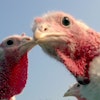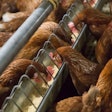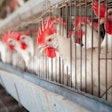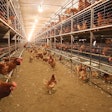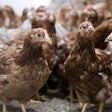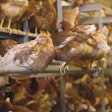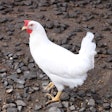
With new cases still being detected on South Korean farms, officials have announced several measures to ramp up control of highly pathogenic avian influenza (HPAI).
For the current HPAI “season,” which began in October of last year, South Korea’s total confirmed outbreaks on poultry farms currently stands at 75. This is according to the latest updates from the agriculture ministry. So far, all outbreaks have been linked to the H5N1 HPAI virus serotype, which has been circulating widely across the globe.
In South Korea, the poultry most affected by HPAI have been meat ducks and laying hens. The two most recent outbreaks occurred in meat ducks at two farms in South Jeolla province. With around 14,000 and 15,000 birds, the premises were located in the counties of Yeongam and Jangheung, respectively, and around 300 km south of the capital, Seoul.
Around one week ago, the South Korean authorities officially registered 18 further farm outbreaks.
According to the notification to the World Organisation for Animal Health (WOAH), these began between December 30, 2022 and April 7. Directly impacted in these outbreaks were around 945,600 poultry through mortality or culling in six different provinces, including South Jeolla. While one of the affected premises had just eight poultry, all the others were commercial flocks, each with between 16,000 and 129,000 birds.
Six of these 18 new outbreaks affected meat ducks, and five had laying hens. Also involved were native chickens, broilers, and quail, while three outbreaks were in unspecified types of poultry.
These 18 outbreaks correspond approximately to those occurring since the start of 2023. Since the first HPAI cases linked to this virus variant in November of 2021, South Korea has confirmed with WOAH a total of 120 outbreaks affecting more than 8.82 million poultry.
South Korea strengthens disease controls
As a result of the ongoing HPAI situation in South Korea, the agriculture ministry has announced changes towards even more stringent hygiene controls for poultry farms.
First of these is the application of enhanced requirements for disinfection currently applied to farms with chickens and ducks will be extended to cover also quails, turkeys, geese, ostriches, and pheasants.
Furthermore, the ministry has rules that premises with more than 100,000 laying hens are required to install and use tunnel disinfection facilities. Last but not least, farm cars and vans will need to be registered in future, as well as larger vehicles such as trucks, as at present. This is because all wheeled vehicles carry the same risk of spreading the HPAI viruses, the ministry explained.
To allow sufficient time for poultry owners to expedite these changes, they will not come into force until October 19.
HPAI outbreaks in other Asian poultry
In Japan, the number of HPAI outbreaks linked to the H5N1 virus serotype had risen to 83 by the first week of April. This is according to WOAH notifications from the national animal health agency. Since the HPAI season began in October of last year, more than 17.55 million Japanese poultry have been directly affected in outbreaks.
Most recent outbreaks registered with WOAH were the second and third premises to be infected in the Chitose city area. Located on the northernmost main island of Hokkaido, both the farms had laying hens — a total of 678,500 birds between them.
As elsewhere, wild birds in Japan have also been testing positive for the H5N1 virus during the current season. In addition, more than 50 have been infected with an H5 virus that could not be identified further. These include 13 crows found dead at seven locations in the country last month.
Furthermore, the H5N8 virus has recently been isolated from two cranes found dead on the southernmost main island of Kyushu. This was the first detection of this virus variant in the country since November of 2021.
In Taiwan, the number of H5N1 HPAI outbreaks in poultry has risen to 48 for the “season,” which began in mid-November. Directly impacted have been more than one million of the territory’s poultry, according to WOAH notifications.
Starting in the second half of March, the five latest outbreaks to be reported involved a total of almost 42,600 birds. Affected were native chickens, meat ducks, and chickens, as well as a small mixed flock in four different regions.
Further human case of avian influenza in China
In the Western Pacific region, one additional infection with avian influenza A virus of avian origin has been registered with the World Health Organization (WHO).
Found to be infected with the avian influenza A(H3N8) virus was a 56-year-old woman in China’s Guangdong province. Her symptoms began at the end of February, she was admitted to hospital in early March, and died on March 16. She is reported to have had multiple underlying health problems. Samples collected from a wet market the patient had previously visited tested positive for H3.
This latest case brings to three the number of lab-confirmed human infections with avian influenza A(H3N8) in the Western Pacific region, according to WHO. This latest case was the only patient to have died with this infection.
View our continuing coverage of the global avian influenza situation.

